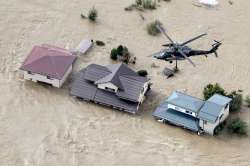Typhoon Hagibis: Rescue efforts underway after unprecedented rains flood Japan
Typhoon Hagibis made landfall south of Tokyo Saturday and moved northward. More than 100 people were also injured in its wake, according to public broadcaster NHK, as the numbers kept growing.

Helicopters plucked people from their flooded homes on Sunday as rescue efforts went into full force in wide areas of Japan, including Tokyo, after a powerful typhoon unleashed heavy rainfall, leaving at least four dead and 17 missing.
Typhoon Hagibis made landfall south of Tokyo Saturday and moved northward. More than 100 people were also injured in its wake, according to public broadcaster NHK, as the numbers kept growing.
News footage showed a rescue helicopter hovering in a flooded area in Nagano prefecture where an embankment of the Chikuma River broke. The chopper plucked those stranded on the second floor of a home submerged in muddy waters.
A stretch of Fukushima, in the city of Date, was also flooded with only rooftops of residential homes visible in some areas. Parts of nearby Miyagi prefecture were also under water.
The Tama River, which runs by Tokyo, overflowed its banks.
Authorities warned of a risk of mudslides. Among the reported deaths were those whose homes were buried in landslides. Other fatalities included people who got swept away by raging rivers .
Some 286,000 homes were without electricity. Several train service in the Tokyo area resumed early morning, although others were undergoing safety checks and were expected to restart later Sunday.
Ruling party politician Fumio Kishida said the government will do its utmost in rescue operations, including making sure that those who moved to shelters were taken care of.
He acknowledged Japan’s power grids need to be strengthened so people in disaster areas can rely on timely information.
“So many risks remain, and it is a reality we must stay on guard,” Kishida said on an NHK TV news talk show. “We must do our utmost. In these times, a disaster can hit anytime.”
The World Rugby Cup match between Namibia and Canada, scheduled for Sunday in Kamaishi, northern Japan, was canceled as a precautionary measure.
All other matches scheduled for Saturday had been canceled. Stores and amusement parks had been closed.
As the typhoon bore down on Saturday with heavy rains and strong winds, the usually crowded train stations and streets of Tokyo were deserted with people advised to stay indoors. But life was quickly returning to normal under crisp clear skies Sunday.
About 17,000 police and military troops were on standby for rescue operations.
Evacuation centers had been set up in coastal towns with tens of thousands seeking shelter. Kyodo News service said evacuation warnings had been issued to more than 6 million people.
The typhoon disrupted a three-day weekend in Japan that includes Sports Day on Monday. Qualifying for a Formula One auto race in Suzuka was pushed from Saturday to Sunday.
The authorities had repeatedly warned Hagibis was on par with a typhoon that hit the Tokyo region in 1958. But the safety infrastructure that Japan’s modernization had brought were apparent. The typhoon six decades ago had left more than 1,200 people dead and half a million houses flooded.